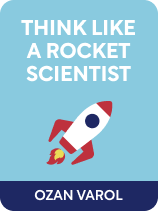

This article is an excerpt from the Shortform book guide to "Think Like a Rocket Scientist" by Ozan Varol. Shortform has the world's best summaries and analyses of books you should be reading.
Like this article? Sign up for a free trial here .
Is bias holding you back from achieving your goals? How can you overcome bias?
Everyone has biases of one kind or another. Those who strive to achieve great things have to find a way to overcome bias so that it doesn’t get in the way of clear thinking and action. Author and former rocket scientist Ozan Varol suggests two ways you can get these blind spots out of your way.
Read more to learn how to overcome bias.
Is Bias in Your Way?
According to Varol, one thing that holds us back from pursuing moonshots is cognitive bias. One powerful form of bias is confirmation bias: We’re more likely to seek out information that confirms our existing beliefs and ignore information that contradicts those beliefs.
Another powerful bias is the narrative fallacy: We tell ourselves a story about the world around us and then cling (or “anchor”) to that story even when it’s being proven false in front of our eyes. Varol argues that this is especially dangerous when our opinions become part of our identities—in that case, changing our opinions on a subject threatens the very core of how we see ourselves.
| The Origins of Bias and How to Avoid It In Thinking, Fast and Slow, Daniel Kahneman offers insight into how these biases develop. According to Kahneman, human thinking happens in two distinct systems: System 1 involves immediate, unconscious thinking and System 2 involves higher-level, deliberate, conscious thinking. We often call on System 2 to double-check our intuitive System 1 thoughts. However, Kahneman argues that in the case of confirmation bias, we often don’t think to call in System 2 because being proven right feels good emotionally, so System 1 doesn’t send up any red flags. A similar process happens with the narrative fallacy: The story we tell ourselves feels right, so we don’t think to question it. So, how can we avoid falling into these cognitive traps? According to Kahneman, we’re more prone to biased thinking when our higher-level cognitive resources are taxed by exhaustion or stress. Therefore, to avoid bias, make your most important decisions when you’re relaxed and well-rested. |
How Rocket Scientists Overcome Bias
Varol says that scientists, on the other hand, see their initial opinions as working hypotheses, not as fact. Their goal is to test those hypotheses—which, in the best case, means trying to disprove them, not prove them. When scientists fail to disprove a theory, their faith in the theory grows; when they succeed, they advance knowledge for everyone (like how historical scientists advanced our understanding of the world by proving that the Earth is not flat). Scientists have no use for hypotheses that aren’t falsifiable because if there is no possible way of proving a theory wrong, you can never know if it’s right. (Shortform note: Hypotheses that can be disproven are called “falsifiable.” Falsifiable hypotheses can be disproven with a single piece of evidence to the contrary. For example, the hypothesis, “Our sun is the smallest star in the galaxy” can be disproven by finding a single star smaller than the sun.)
How You Can Overcome Bias
Varol offers two suggestions for overcoming bias:
1) Come up with more than one hypothesis. Varol argues that when you have one hypothesis, no matter how tentative, you’re guaranteed to anchor to it. To avoid that, come up with multiple hypotheses that conflict with one another. This will help prevent you from anchoring too much to any of them. (Shortform note: This advice is easier said than done, especially if you’re working on a project that you’re passionate about. According to Ryan Holiday in Ego Is the Enemy, passion can actually derail success when we get so caught up in one idea that we become unable to see any flaws in our ideas.)
2) Look at your beliefs as though they were someone else’s. This gives you some distance that can help you maintain objectivity.
However, you can only do this up to a point, as it’s impossible to identify all your own blind spots. To do that, you’ll need to run your opinions by other people and let them poke holes in your ideas. (Shortform note: In Principles: Life and Work, Ray Dalio recommends weighing other people’s opinions of your ideas based on how qualified they are to comment on the subject. Take the judgments of inexperienced people with a grain of salt.)

———End of Preview———
Like what you just read? Read the rest of the world's best book summary and analysis of Ozan Varol's "Think Like a Rocket Scientist" at Shortform .
Here's what you'll find in our full Think Like a Rocket Scientist summary :
- How to solve problems like billionaire entrepreneur Elon Musk
- Why you should treat your ideas like scientific hypotheses
- How to bounce back from failure and avoid complacency after success






